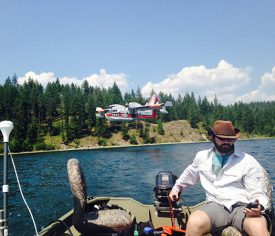by Timothy Taylor, Washington State University, School of the Environment, Pullman, WA
Ph.D. Candidate in Environmental and Natural Resource Sciences
Co-Authors: Barry Moore, Associate Professor at Washington State University, School of the Environment, Pullman, WA
Benjamin Cross, Principal Fisheries Biologist for the Colville Tribes Fish and Wildlife Department, Omak, WA
Fishing is important to outdoor enthusiasts, many of whom inherited their love of the sport as a legacy from earlier generations. Some may enjoy the fight of a four-pound rainbow trout on a lightweight rod, while others also harvest fish to supplement their diet. Ensuring ample fishing opportunities for the general public has been the goal of fisheries managers. Reaching this goal often requires extensive knowledge of how populations change, which we call population dynamics. Monitoring vital rates (growth, mortality) and recruitment (young fish entering the fishery) is crucial to proper fisheries management. To understand these factors, we need age data. Age is documented well for humans, with birth certificates, passports and driver’s licenses, or we can simply ask someone how old they are. Interpreting age for fish is not as straightforward. We typically must infer age from “nature’s documentation,” defined as growth rings deposited on calcified structures.
Calcified structures used to age fish include scales, otoliths (a calcified deposit in the inner ear), fin rays, spines, and vertebrae (Maceina et al. 2007). Growth rings can be interpreted from these structures, though some may not accurately depict the fish’s true age (like a counterfeit driver’s license). Therefore, fisheries managers are interested in estimating the accuracy and precision of age estimates. Accuracy, or age validation, refers to how closely the estimated structure age matches a fish’s true age. Precision, or age verification, is a measure of how consistently a structure matches its age. It is important to age fish using a calcified structure that has been validated, and if we use another structure, it needs to be verified (Campana 2001). The moral of the story is this: when data is collected, we need to make sure it is accurate because inaccurate data can misinform fisheries managers about a fishery’s status (Campana 2001). To complicate matters, structure age accuracy varies across species (Maceina et al. 2007), and some structures cannot be collected without terminating (i.e., killing) the fish!
Our study lake, Owhi Lake, is located on the Confederated Tribes of the Colville Reservation (CTCR), and harbors only one fish species, brook trout. Why is this nonnative species important? There are two main reasons: 1) brook trout are a part of the CTCR supplemented fisheries, which means they are stocked into lakes to help support tribal fisheries; and 2) Owhi Lake brook trout include a self-sustaining population that serves as their broodstock source (fish used to stock other closed-basin lakes on the reservation). The CTCR want to ensure that this fishery is currently sustainable, which requires accurate age data.
Past research has suggested that for stream-dwelling brook trout, scales could be used to estimate age for young fish, but older fish should be aged with otoliths (Stolarski and Hartman 2008). There are a couple of interesting points to note about this study: growth patterns differ between stream-dwelling brook trout and their lake-dwelling counterparts (Stolarski and Hartman 2010); and stream-dwelling fish are short-lived and smaller compared to Owhi Lake brook trout. These two factors indicate that not all age-classes were evaluated for brook trout in the previous study, and different growth patterns may change how annuli (growth rings) are interpreted across structures.
Given that brook trout true age has been validated in the past, and otoliths were shown to reflect true age (Hall 1991), we investigated whether non-lethal age structures (scales and pectoral fin rays) could precisely estimate age. In the fall of 2015, we collected 157 fish of varying length, and then processed structures back in our lab. To ensure that age estimates can be replicated, we had three technicians age each structure independently. We used age-bias plots, percent agreement, and coefficients of variation to evaluate how age estimates varied across readers and between structures—in other words, we determined whether age estimates from non-lethal structures matched otolith age, and whether readers could provide consistent age estimates.
Our preliminary results indicate that fin rays might be an alternative structure to estimate brook trout age. We emphasize might be because not all readers’ fin ray age estimates matched the otolith ages. Possible reasons for this variability include differences in training, structure clarity, or between-reader bias. Ultimately, structures used to estimate fish age should be consistent across readers. We are currently finalizing this study to try to improve structure clarity and ensure that all readers are similarly trained.
In summary, our preliminary results suggest the potential of aging brook trout using fin rays rather than otoliths, though we are still working out the kinks. If this trend holds true, we will have provided CTCR with a valuable, non-lethal alternative to otolith aging, further protecting their important broodstock. Additionally, these results may be replicable to fish in their native range. Final results will be presented via poster at the next WALPA conference, so stay tuned!
References
Campana, S. E. 2001. Accuracy, precision, and quality control in age determination, including a review of the use and abuse of age validation methods. Journal of Fish Biology. 59: 197-242.
Hall, D. L. 1991. Age validation and aging methods for stunted Brook Trout. Transactions of the American Fisheries Society. 120(5): 644-649.
Maceina, M. J., J. Boxrucker, D. L. Buckmeier, R. S. Gangl, D. O. Lucchesi, D. A. Isermann, P. J. Martinez. 2007. Current status and review of freshwater fish aging procedures used by state and provincial fisheries agencies with recommendations for future directions. Fisheries. 32(7): 329-340.
Stolarski, J.T., and K.J. Hartman. 2008. An evaluation of the precision of fin ray, otolith, and scale age determinations for Brook Trout. North American Journal of Fisheries Management. 28(6): 1790-1795.
Stolarski, J. T., and K. J. Hartman. 2010. Comparisons of growth and condition of fluvial and resident Brook Trout within partially migratory populations. Fisheries Management and Ecology. 17(1): 33-39.











